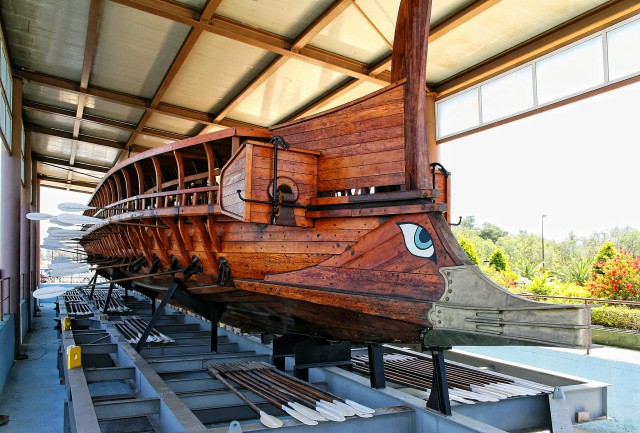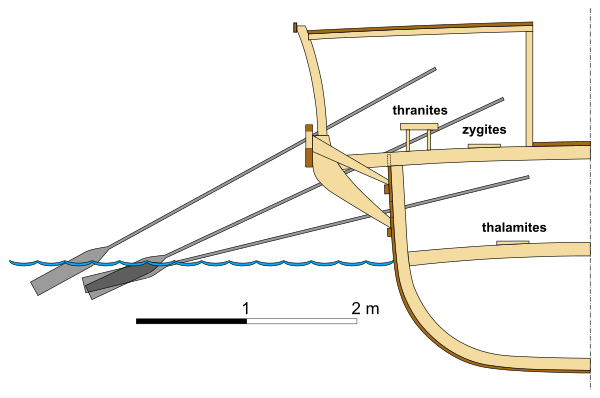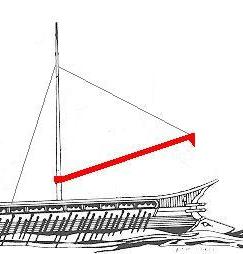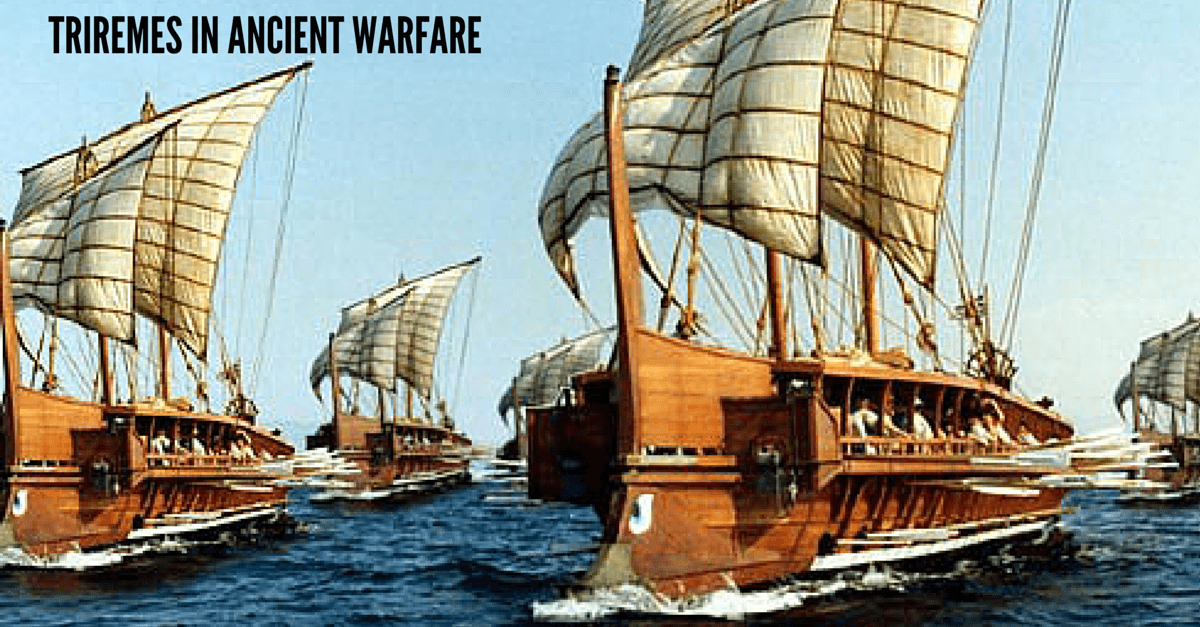Ancient warfare relied on steel weapons, but continually evolved with differences in equipment and tactics. Naval warfare was a simpler affair, find the enemy ship and ram into its side under oar power. The most stable aspect of ancient warfare was the trireme, which dominated the seas for a thousand years. The basic design of the trireme was so efficient that it was only improved through increases in size, making the quadriremes and larger vessels with the same basic structure. To build the triremes used wooden pegs and dowels to hold the planks together, loosely at first. when a ship was first launched the wood would absorb enough water to expand the hull and make it watertight.

The trireme was developed by the Greeks and Phoenicians around the 8th century BCE. The Phoenicians, being extensive traders, developed a ship that was long and narrow with a heavy bronze ram at the prow. The ram rested just below the surface and in battle was powered forward by three rows of oars on either side giving the ship its name, trireme. When not in battle the trireme had at least one central mast and sail for wind power.
In battle the goal was to ram the bronze prow into the weak flanks of the enemy ship. While this was an easy concept, the maneuvering was incredibly difficult and a various angles of attack made seamanship and quality construction extremely important. The Phoenicians had access to a large amount of timber and were able to build a large trade fleet and capable triremes.

The most memorable adopters of the trireme were the Athenians. The Athenians prided themselves on the skill of their navy and the quality of their ships. Their skill was on full display during the naval battle of Salamis. As the vastly more numerous Persian navy went into the straights of Salamis the Athenian led navy outmaneuvered the slow-moving Persian ships to break the back of the Persian invasion.
Depictions of the close quarter’s battle show the varied combat that could be expected from triremes. Some ships broke cleanly in half as a well-aimed ram struck true. Other ships collided at an angle and hand to hand marine combat ensued. All the while missile fire swept through the decks from archers and those ships armed with catapults.
The engine of the ship, the rowers, numbered 170 of the total detachment of 200 crewmen. Far from slaves, the rowers were highly trained professionals who had a very important job. Most rowers were lower class citizens who needed steady pay. The deck officers included the captain and watchmen, as well as several officers in charge of coordinating the rowing. Getting 170 men to row in order was quite difficult, but the results were impressive when synchronization was reached. At Salamis the skill of the Athenians allowed for faster and sharper cuts in the water to create better angles of attack and the heavier armed hoplite marines were more than a match for Persian archers and marines. Even when out of battle, a well-disciplined group of rowers could easily move twice as fast as the average trireme.

Another example of an ancient maritime power is Carthage. Carthage had an impressive military harbor and prime position to trade in the Mediterranean. At the outbreak of the first Punic War with Rome, the Carthagians were a dominate force and easily defeated the poorly trained Romans. Then the Romans developed a special second weapon for their triremes, the Corvus. The Corvus was a long, wide plank which stood vertically on the side of the ship and had a large hook so it could slam down and secure itself to an enemy trireme. Once secure the Romans would charge over and make a naval battle a land one, which the ferocious Roman infantry easily won.
As Rome established dominion in the Mediterranean the size of the trireme grew. This growth was prompted by triremes adding more armor to their vulnerable sides which required larger ships with more rowers to break opposing ships. Larger ships such as the quinquereme were still based of the design of the trireme, with three banks of oars on each side, but were larger and employed more men on each oar for more power. Though triremes could hardly have a chance of breaking through the much larger versions, it was still heavily used by many states as a basic ship, which could be used in groups to take down larger ships with artillery or missile fire.
Triremes were profoundly influential in ancient warfare, so much so that they were practically the only military ships on the seas for hundreds of years, and their variants lasted until the fall of Rome. The unique nature of trireme battles required huge amounts of manpower and sunken ships almost always meant the loss of the entire crew. Captured ships were also a huge shift in power. The use of the trireme meant that one naval battle could easily decide the outcome of a war. The Persian invasion was crippled at the battle of Salamis, and Carthage lost the first Punic War largely because they lost too many skilled sailors to continue. The trireme and its variants fell out of regular use and further development after Roma had secured the seas and it wasn’t until the Byzantine era when a new dominant vessel, the Dromon, dominated the seas.
By William McLaughlin for War History Online
